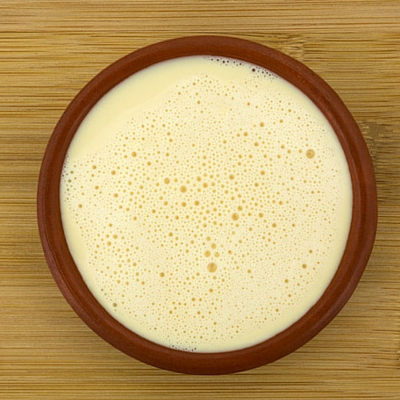A variation of evaporated milk is sweetened condensed milk, which has added sugar. A much sweeter and richer product, condensed milk has a longer shelf life and is often used in ice cream or candy manufacturing.2
Origin
The idea for evaporated milk was born as a solution for transporting milk in the 1850s. During that time, bacteria made drinking and shipping milk a risky business. Gail Borden, a dairy farmer, considered this problem while accompanying his milk cows on a ship from London to the United States. The cows became seasick, so they could not be milked to feed hungry infant passengers.
Once home, Borden began testing ways to process and package milk to endure long journeys. After discovering milk was over 80 percent water, Borden boiled the water off the top to create evaporated milk. After further tests, obtaining a patent, and teaming up with grocery wholesale owner Jeremiah Milbank, the first Eagle Brand Consolidated Milk production plant was opened in 1864.
Evaporated milk was not an instant success. Consumers had a hard time getting used to the taste and it was blamed for an outbreak of rickets in 1905, due to its lack of nutrients. However, the Union Army purchased evaporated milk in 1861 for rations, which helped boost the product’s popularity. Today, under two percent of all U.S. milk production is evaporated or condensed.
Application
Evaporated milk is easy to incorporate into almost any recipe and product. It can be purchased in low-fat and fat free options. Bakers often use it as a substitute for cream to help reduce fat content.
To substitute for a cup of regular milk, add in one part evaporated milk and one part water. For a more fresh-milk taste, add half the called for milk with evaporated milk, and the rest with water. Cream can also be used to even out the evaporated milk instead of water. Evaporated milk is stored at room temperature, and it is advised against freezing it.
FDA regulation
Under FDA regulations, evaporated milk should contain at least 6.5 percent by weight of milk fat, 16.5 percent by weight of milk solids not fat, and 23 percent by weight of total milk solids. There must also be 25 international units of vitamin D. Evaporated milk is recognized as GRAS by the FDA.
References
- Muir, D. D. “The Stability and Shelf Life of Milk and Milk Products.” The Stability and Shelf Life of Milk and Milk Products. Woodhead Publishing Series in Food Science, Technology and Nutrition, 2011. Web. 24 Aug. 2015.
http://www.sciencedirect.com/science/article/pii/B978184569701350027X - Crowe, L.k., and Darrell D. Deane. “A Study of the Characteristics of a Milk Supply as Related to the Manufacture of Plain Condensed Skimmilk for Ice Cream Making.” Journal of Dairy Science 23.9 (1940): 919-29. Web.

